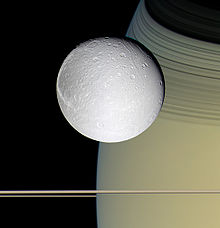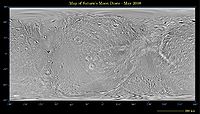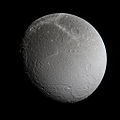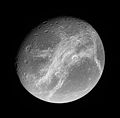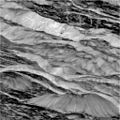- Dione (moon)
-
For other uses, see Dione.
Dione 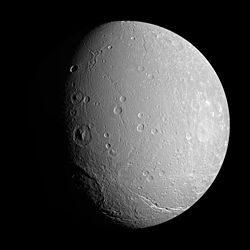 Cassini view of Dione's leading hemisphere. The large craters on or near the terminator are (from bottom to top) Evander, Erulus, Lagus and Sagaris. The Palatine Chasmata fractures stretch across the lower right limb, and the trough Aufidus Catena extends along the bottom near the south pole.Discovery
Cassini view of Dione's leading hemisphere. The large craters on or near the terminator are (from bottom to top) Evander, Erulus, Lagus and Sagaris. The Palatine Chasmata fractures stretch across the lower right limb, and the trough Aufidus Catena extends along the bottom near the south pole.DiscoveryDiscovered by Giovanni Cassini Discovery date March 21, 1684 DesignationsAlternate name(s) Saturn IV Adjective Dionean Semi-major axis 377 396 km Eccentricity 0.002 2[1] Orbital period 2.736 915 d[1] Inclination 0.019° (to Saturn's equator) Satellite of Saturn Physical characteristicsDimensions 1128.8 × 1122.6 × 1119.2 km[2] Mean radius 561.4 ± 0.4 km[2] (348.96 mi) Mass (1.095 452 ± 0.000 168)×1021 kg[3] (3.28×10−4 Earths) Mean density 1.478 ± 0.003 g/cm³[2] Equatorial surface gravity 0.233 m/s2 Escape velocity 0.51 km/s Rotation period 2.736 915 d
(synchronous)Axial tilt zero Albedo 0.998 ± 0.004 (geometric)[4] Temperature 87 K (-186°C) Apparent magnitude 10.4 [5] Dione (
 /daɪˈoʊniː/;[6] Greek: Διώνη) is a moon of Saturn discovered by Cassini in 1684.[7] It is named after the titan Dione of Greek mythology. It is also designated Saturn IV.
/daɪˈoʊniː/;[6] Greek: Διώνη) is a moon of Saturn discovered by Cassini in 1684.[7] It is named after the titan Dione of Greek mythology. It is also designated Saturn IV.Contents
Name
Cassini named the four moons he discovered (Tethys, Dione, Rhea and Iapetus) Sidera Lodoicea ("the stars of Louis") to honor king Louis XIV. Cassini found Dione using a large aerial telescope he set up on the grounds of the Paris Observatory.[8] The satellites of Saturn were not named until 1847, when William Herschel's son, John Herschel published Results of Astronomical Observations made at the Cape of Good Hope, and suggested the names of the Titans, sisters and brothers of Cronos (the Greek Saturn), be used.[9]
Physical characteristics
See also: List of geological features on Dione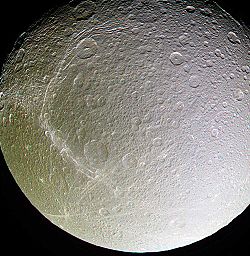 Cassini enhanced-color composite of Dione, showing the darker, fractured terrain of the trailing hemisphere. The Padua Chasmata trace an arc on the left, interrupted near the top by central peak crater Ascanius. The Janiculum Dorsa extend along the upper right terminator.
Cassini enhanced-color composite of Dione, showing the darker, fractured terrain of the trailing hemisphere. The Padua Chasmata trace an arc on the left, interrupted near the top by central peak crater Ascanius. The Janiculum Dorsa extend along the upper right terminator.
At 1122 km in diameter, Dione is the 15th largest moon in the Solar System, and is more massive than all known moons smaller than itself combined.[10] It is composed primarily of water ice, but as the third densest of Saturn's moons (after Enceladus and Titan, whose density is increased by gravitational compression) it must have a considerable fraction (~ 46%) of denser material like silicate rock in its interior.
Though somewhat smaller and denser, Dione is otherwise very similar to Rhea. They both have similar albedo features and varied terrain, and both have dissimilar leading and trailing hemispheres. Dione's leading hemisphere is heavily cratered and is uniformly bright. Its trailing hemisphere, meanwhile, contains an unusual and distinctive surface feature: a network of bright ice cliffs.
Scientists recognise Dionean geological features of the following types:
- Chasmata (chasms; long, deep, steep-sided depressions)
- Dorsa (ridges)
- Fossae (long narrow depressions)
- Craters
- Catenae (crater chains)
 Crescent Dione from Cassini, October 11 2005. The crater near the limb at top is Alcander, with larger crater Prytanis adjacent to its left. At lower right, several of the Palatine Chasmata fractures are visible, one of which can be seen bisecting the smaller craters Euryalus (right) and Nisus.
Crescent Dione from Cassini, October 11 2005. The crater near the limb at top is Alcander, with larger crater Prytanis adjacent to its left. At lower right, several of the Palatine Chasmata fractures are visible, one of which can be seen bisecting the smaller craters Euryalus (right) and Nisus.
The ice cliffs (formerly 'wispy terrain')
When the Voyager space probe photographed Dione in 1980, it showed what appeared to be wispy features covering its trailing hemisphere. The origin of these features was mysterious, as all that was known was that the material has a high albedo and is thin enough that it does not obscure the surface features underneath. One hypothesis was that shortly after its formation Dione was geologically active, and some process such as ice volcanism resurfaced much of its surface, with the streaks forming from eruptions along cracks in Dione's surface that fell back to the surface as snow or ash. Later, after the internal activity and resurfacing ceased, cratering continued primarily on the leading hemisphere and wiped out the streak patterns there.
This theory was proven wrong by the Cassini probe flyby of December 13, 2004, which produced close-up images. These revealed that the 'wisps' were in fact not ice deposits at all, but rather bright ice cliffs created by tectonic fractures; Dione has been revealed as a world riven by enormous fractures on its trailing hemisphere.
The Cassini orbiter performed a closer flyby of Dione at 500 km (310 mi) on October 11, 2005, and captured oblique images of the cliffs, showing that some of them are several hundred metres high.
Craters
Dione's icy surface includes heavily cratered terrain, moderately cratered plains, lightly cratered plains, and areas of tectonic fractures. The heavily cratered terrain has numerous craters greater than 100 kilometres (62 mi) in diameter. The plains areas tends to have craters less than 30 kilometres (19 mi) in diameter. Some of the plains are more heavily cratered than others. Much of the heavily cratered terrain is located on the trailing hemisphere, with the less cratered plains areas present on the leading hemisphere. This is the opposite of what some scientists expected; Shoemaker and Wolfe[11] proposed a cratering model for a tidally locked satellite with the highest cratering rates on the leading hemisphere and the lowest on the trailing hemisphere. This suggests that during the period of heavy bombardment, Dione was tidally locked to Saturn in the opposite orientation. Because Dione is relatively small, an impact causing a 35 kilometer crater could have spun the satellite. Since there are many craters larger than 35 kilometres (22 mi), Dione could have been repeatedly spun during its early heavy bombardment. The pattern of cratering since then and the bright albedo of the leading side suggests that Dione has remained in its current orientation for several billion years.
Like Callisto, Dione's craters lack the high relief features seen on the Moon and Mercury; this is probably due to slumping of the weak icy crust over geologic time.
Exploration
Dione was first imaged by the Voyager space probes. It has also been imaged several times from closer distances by the Cassini orbiter. There was one close targeted fly-by, at a distance of 500 km on 2005 October 11; another similarly close fly-by was performed on 2010 April 7. A third fly-by is scheduled for 2011 December 12 at an altitude of 99 km..
See also
- Dione in fiction
- The moon Helene, which orbits in Dione's leading Lagrangian point, L4.
- The moon Polydeuces orbits in Dione's trailing Lagrangian point, L5.
Gallery
-
Dione as seen by Voyager 1; the craters prominent at upper and lower left are Dido and Aeneas.
-
Differently sized and oriented fractures within a 60-km crater (central peak at lower right).
References
- ^ a b http://exp.arc.nasa.gov/downloads/celestia/data/solarsys.ssc Exp.arc.nasa.gov Retrieved on 05-21-07
- ^ a b c Roatsch, T.; Jaumann, R.; Stephan, K.; Thomas, P. C. (2009). "Cartographic Mapping of the Icy Satellites Using ISS and VIMS Data". Saturn from Cassini-Huygens. pp. 763–781. doi:10.1007/978-1-4020-9217-6_24. ISBN 978-1-4020-9216-9.
- ^ Jacobson, R. A.; Antreasian, P. G.; Bordi, J. J.; Criddle, K. E.; et al. (December 2006). "The Gravity Field of the Saturnian System from Satellite Observations and Spacecraft Tracking Data". The Astronomical Journal 132 (6): 2520–2526. Bibcode 2006AJ....132.2520J. doi:10.1086/508812.
- ^ Verbiscer, A.; French, R.; Showalter, M.; and Helfenstein, P.; Enceladus: Cosmic Graffiti Artist Caught in the Act, Science, Vol. 315, No. 5813 (February 9, 2007), p. 815 (supporting online material, table S1)
- ^ "Classic Satellites of the Solar System". Observatorio ARVAL. http://www.oarval.org/ClasSaten.htm. Retrieved 2007-09-28.
- ^ In US dictionary transcription, US dict: dī·ō′·nē.
- ^ Cassini, G. D.; An Extract of the Journal Des Scavans. of April 22 st. N. 1686. Giving an account of two new Satellites of Saturn, discovered lately by Mr. Cassini at the Royal Observatory at Paris, Philosophical Transactions, Vol. 16 (1686-1692), pp. 79-85.
- ^ Fred William Price - The planet observer's handbook - page 279
- ^ As reported by William Lassell, Monthly Notices of the Royal Astronomical Society, Vol. 8, No. 3, pp. 42–43 (January 14, 1848)
- ^ See note g Triton (moon)#Notes
- ^ Shoemaker, E. M.; and Wolfe, R. F.; Cratering time scales for the Galilean satellites, in Morrison, D., editor; Satellites of Jupiter, University of Arizona Press, Tucson (AZ) (1982), pp. 277-339
External links
Listen to this article (info/dl)
This audio file was created from a revision of Dione (moon) dated 2010-01-18, and does not reflect subsequent edits to the article. (Audio help)More spoken articles- Dione Profile at NASA's Solar System Exploration site
- The Planetary Society: Dione
- NASA probe video of approach to Dione
- Cassini images of Dione
- Images of Dione at JPL's Planetary Photojournal
- Dione basemap (May 2008) from Cassini images
- Dione atlas (August 2008) from Cassini images
- Dione nomenclature and Dione map with feature names from the USGS planetary nomenclature page
Moons of Saturn Generally listed in increasing distance from Saturn. Temporary names in italics.Ring shepherds - S/2009 S 1
- Propeller moonlets
- Pan
- Daphnis
- Atlas
- Prometheus
- ?(S/2004 S 6
- S/2004 S 4
- S/2004 S 3)
- Pandora
Co-orbitals G Ring - Aegaeon
Inner large
(with Trojans)Alkyonides Outer large Inuit group Norse group Gallic group Natural satellites of the Solar System Planetary satellites 
Other satellite systems Largest satellites - Inner satellites
- Trojans
- Irregulars
- List
- Timeline of discovery
- Naming
Categories:- Greek loanwords
- Moons of Saturn
- Astronomical objects discovered in 1684
Wikimedia Foundation. 2010.


